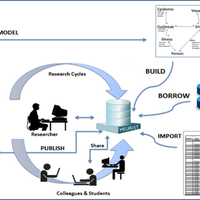From pipe dreams and waste to functional accretion: building a capable infrastructure for the Digital Humanities
- Track: Open Research Tools and Technologies devroom
- Room: D.research
- Day: Saturday
- Start: 10:05
- End: 10:25
- Video with Q&A: D.research
- Video only: D.research
- Chat: Join the conversation!

This presentation is about the development and trajectory of Heurist (HeuristNetwork.org), a shared, integrated, extensible data infrastructure (model, build, manage, analyse, visualise, share, publish via integrated CMS) for Humanities research capable of handling the needs of many heterogeneous projects on a single standalone service*, with optional integration across multiple servers by a coordinating index (itself based on Heurist).
Humanities data are interesting (both technically and to the public). They are rich in text, images, objects, people and events, heterogeneous, eminently linkable and sparse-matrix. Personal computers, the internet and other accessible technologies have spawned an exploding field (or fad?) known as Digital Humanities (DH), and opened exciting new horizons for research and public engagement.
However, this technological turn has created many problems for a poorly funded research culture with 1-3 year grant funding cycles - choice of appropriate technology, finding and retaining technical staff, initial and ongoing costs, sustainability ... The outcome is often least-effort and inadequate technology (eg. spreadsheets) or ad hoc development, incomplete functionality, maintenance nightmares, data silos and rapid end-of-funding decay; only rich or statutory organisations can maintain a multi-component system for long. Heurist aims to overcome these problems by mutualised Open Source development, schemas stored as editable data rather than fixed structures, demand-driven priority development, and free centralised services and maintenance.
In this presentation I will outline the evolution of our development process, from haphazard experimentation and many costly unused features (2005 - 2009) to a coherent, stable but evolving structure and Extreme Programming (aka living dangerously!), driven by immediate user requirements and incremental daily interface refinement. I will outline some of the fundamental principles we use to maintain backwards compatibility, stability, rapid development and low cost of maintenance for such a complex beast and for so many projects, on a self-funding staff of just 3 FTE. I also hope to attract some technical collaborators, as most of our users are (by design) non-technical.
- We maintain a central index and two free services (based in Australia and France), plus some institution-based servers, currently supporting a couple of hundred research projects in different fields, ranging from doctoral students to networks of researchers.
Speakers
| Ian Johnson |